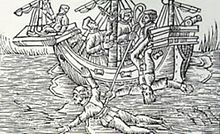
The Second Anglo-Dutch War, or Second Dutch War, began on 4 March 1665, and concluded with the signing of the Treaty of Breda on 31 July 1667. One in a series of naval conflicts between England and the Dutch Republic, its causes were a combination of political differences and commercial disputes.

Johan Anthoniszoon "Jan" van Riebeeck was a Dutch navigator and colonial administrator of the Dutch East India Company.

The keel is the bottom-most longitudinal structural element on a watercraft. On some sailboats, it may have a hydrodynamic and counterbalancing purpose, as well. The laying of the keel is often the initial step in the construction of a ship. In the British and American shipbuilding traditions, this event marks the beginning date of a ship's construction.

The California State University Maritime Academy is a public university in Vallejo, California. It is part of the California State University system and the only maritime academy on the contiguous West Coast. The university offers six bachelor's degree programs and one master's degree program.
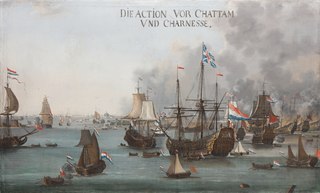
The Raid on the Medway, during the Second Anglo-Dutch War in June 1667, was a successful attack conducted by the Dutch navy on English warships laid up in the fleet anchorages off Chatham Dockyard and Gillingham in the county of Kent. At the time, the fortress of Upnor Castle and a barrier chain called the "Gillingham Line" were supposed to protect the English ships.

Abraham van Riebeeck was a merchant with the Dutch East India Company and the Governor-General of the Dutch East Indies from 1709 to 1713.

A yard is a spar on a mast from which sails are set. It may be constructed of timber or steel or from more modern materials such as aluminium or carbon fibre. Although some types of fore and aft rigs have yards, the term is usually used to describe the horizontal spars used on square rigged sails. In addition, for some decades after square sails were generally dispensed with, some yards were retained for deploying wireless (radio) aerials and signal flags.
This glossary of nautical terms is an alphabetical listing of terms and expressions connected with ships, shipping, seamanship and navigation on water. Some remain current, while many date from the 17th to 19th centuries. The word nautical derives from the Latin nauticus, from Greek nautikos, from nautēs: "sailor", from naus: "ship".
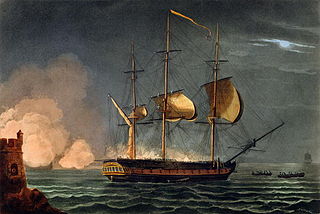
HMS Hermione was the lead ship of the Hermione-class, a six-ship class of 32-gun fifth-rate frigates of the Royal Navy. She was launched on 9 September 1782 at Bristol. Hermione was commissioned and then paid off a number of times during the 1780s. She underwent repairs between October 1790 and June 1792, followed by a period spent refitting at Chatham Dockyard until January 1793. She was recommissioned in December 1792 before sailing to the Jamaica in March 1793. Hermione served in the West Indies during the early years of the French Revolutionary Wars, participating in the British attack on Port-au-Prince, where she led a small squadron that accompanied troop transports.
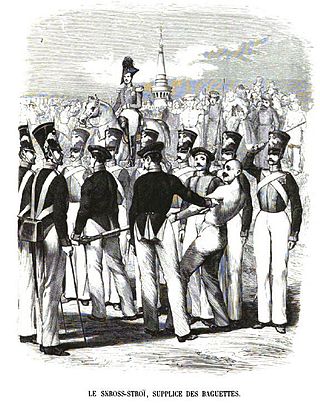
To run the gauntlet means to take part in a form of corporal punishment in which the party judged guilty is forced to run between two rows of soldiers, who strike out and attack them with sticks or other weapons.
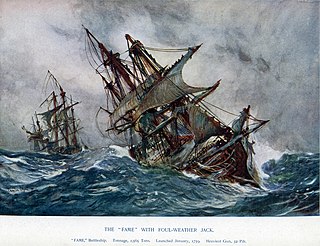
HMS Fame was a 74-gun third-rate ship of the line of the Royal Navy, in service during the Seven Years' War and the American Revolutionary War.

Careening is a method of gaining access to the hull of a sailing vessel without the use of a dry dock. It is used for cleaning or repairing the hull. Before ship's hulls were protected from marine growth by fastening copper sheets over the surface of the hull, fouling by this growth would seriously affect the sailing qualities of a ship, causing a large amount of drag.
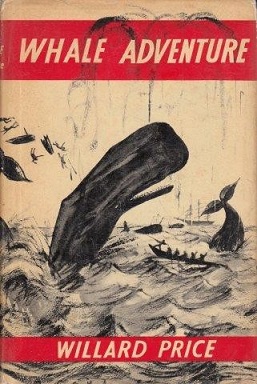
Whale Adventure is a 1960 children's book by the Canadian-born American author Willard Price featuring his "Adventure" series characters, Hal and Roger Hunt.

HNLMS Zuiderkruis (A832) was a replenishment oiler operated by the Royal Netherlands Navy. Zuiderkruis entered service in 1975 and was decommissioned on 10 February 2012. Her design was based on the earlier replenishment ship Poolster. The ship has been stripped for parts and left Den Helder for scrapping in Turkey on 21 February 2014.

Slavery in South Africa existed from 1653 in the Dutch Cape Colony until the abolition of slavery in the British Cape Colony on 1 January 1834. This followed the British banning the trade of slaves between colonies in 1807, with their emancipation by 1834. Beyond legal abolition, slavery continued in the Transvaal though a system of inboekstelsel.

HNLMS Poolster was a replenishment ship serving with the Royal Netherlands Navy. Poolster entered service on 29 June 1964. In 1994 she was decommissioned and sold to the Pakistan Navy where the ship was renamed Moawin. A later replenishment ship Zuiderkruis was based on Poolster. In the Dutch navy she was replaced by the replenishment ship Amsterdam. She was the first ship in the Dutch navy with inbuilt protection against radioactive fallout.

The Admiralty and Marine Affairs Office (1546–1707), previously known as the Admiralty Office (1414–1546), was a government department of the Kingdom of England, responsible for the Royal Navy. First established in 1414 when the offices of the separate Admiral of the North and West were abolished and their functions unified under a single centralised command, it was headed by the Lord High Admiral of England. The department existed until 1707 when England and Scotland united to form the Kingdom of Great Britain, after which it was known as the British Admiralty.

Properly speaking, the history of the Royal Navy began in 1546 with the establishment of the "Navy Royal" by Henry VIII in 1546. This became the Parliamentary Navy during the period of the Commonwealth with the modern incarnation of Royal Navy established in 1660 following the Restoration of King Charles II to the throne. The English navy began operating together with the much smaller Royal Scots Navy at the time of the Union of the Crowns under James I in 1603 but only formally merged in 1707 at the establishment of the united Kingdom of Great Britain.
This glossary of nautical terms is an alphabetical listing of terms and expressions connected with ships, shipping, seamanship and navigation on water. Some remain current, while many date from the 17th to 19th centuries. The word nautical derives from the Latin nauticus, from Greek nautikos, from nautēs: "sailor", from naus: "ship".

Paarden Eiland is a light industrial area of Cape Town, South Africa. It is located on the Table Bay coast about 5 kilometres (3.1 mi) from the city centre.
